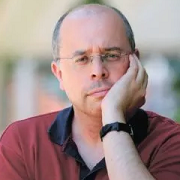PhD dissertation:
Rom, U. B. (2011), Key-Related Aspects of Mozart’s Music with Particular Reference to his Instrumental (in German: Tonartbezogenes Denken in Mozarts Werken unter besonderer Berücksichtigung des Instrumentalwerks) [PhD, Berlin Technical University].
Articles in peer-reviewed journals:
Rom, U. B. (2009). An E-flat Major Motif? Interrelation between Motifs and Keys in Mozart’s Music (in German). Zeitschrift der Gesellschaft für Musiktheorie (ZGMTH), 6, 9–50.
Rom, U. B. (2016). Invited review: Matthew Riley, The Viennese Minor-Key Symphony in the Age of Haydn and Mozart (Oxford University Press, 2014). Music Theory and Analysis (MTA), 3(1), 103–113.
Rom, U. B. (2019). “To Gild Refined Gold,” or What Mozart Didn’t Want Us to Embellish. Music Theory and Analysis (MTA), 6(1), 50–87.
Rom, U. B., Raz, O., Chawin, D. (in press, 2021). The Mozart Expositional Punctuation Corpus: A Dataset of Interthematic Cadences in Mozart’s Sonata-Allegro Expositions. Empirical Musicology Review (EMR), in press.
Papers presented at scientific meetings published in proceedings:
Rom, U. B. (2007), “Mozart and the grief process: Interpreting the string quintet in G minor K.516,” in: Interpretare Mozart: Conveno Internationale di Studi, Milano, 19–21 Maggio 2006, ed. M. Dellaborra, G. Salvetti, C. Toscani, Lucca: Libreria Musicale Italiana, 381–387.
Manuscripts under revision in peer-reviewed journals:
Rom, U. B., and Rosset, S., Key-Related Idioms in Mozart’s Music: A Peek into his Creative Process? (under revision)
Rom, U. B., and Chawin, D., Sliding-Window Pitch-Class Histograms as a Means of Modeling Musical Form (under revision)
Database publication:
The Mozart Expositional Punctuation Corpus – symbolic dataset to be published alongside article accepted for publication in EMR (see above).
Publications of international conference & symposium abstracts:
Rom, U. B. (2011). Structural Deformation as a Token of Undercurrent Humor in Mozart’s Instrumental Rondos. 7th European Music Analysis Conference. Rome, Sep. 29–Oct. 2, 2011.
Rom, U., B. and Rosset, S. (2011). Key-Related Idioms in Mozart’s Music: A Peek into his Creative Process? 34th Annual Meeting of the American Society for Music Theory. Minneapolis, Oct. 27–30, 2011.
Rom, U. B. (2012). Digression to the Parallel Major – Redemption, Facilitation or just a Harmonic faux pas? On the Status of a Harmonic Device in 18th Century Music Theory and Composition. Annual Congress of the German Society for Music Theory. Essen, Oct. 5–7, 2012.
Rom, U. (2014). The Pitfall of Diachronicity: ‘Explicit’ vs. ‘Implicit’ Musical Temporality. 8th European Music Analysis Conference. Leuven, Sep. 17–20, 2014.
Rom, U. B. (2015). Towards an Extended Typology of Enharmonic Progressions. Keele Music Analysis Conference (KeeleMAC). Keele University, July 8–10, 2015.
Rom, U. B. (2017). Making Harmonic Ambiguity Sound – Schoenberg, Escher, Brahms. 9th European Music Analysis Conference (EuroMAC 9). Strasbourg, June 28–July 1, 2017.
Rom, U. B. (2018). The Riddle of the Horn Concerto Fragments and a New Completion of the Concerto Movement in E Major K.494a. Annual meeting of the Israel Musicological Society. Hebrew University, Jerusalem, Feb. 27, 2018.
Rom, U. B. (2019). Bach and the Sequence: From a Harmonic Mechanicality to a Musical Representation of the Transcendental. The Music of Johann Sebastian Bach: New Aspects, New Edition. Jerusalem Academy of Music & Dance, Jerusalem, Feb. 17, 2019.
Rom, U. B. (2019). Musical Punctuation and Temporality in a Corpus of Mozart’s Sonata Expositions. Patterns- Algorithms – Symmetries. UdK Berlin, Berlin, June 28–29, 2019.
Artistic publications:
Rom, U. B. (2001, 2005). Rondo for Natural Horn and Orchestra in E-flat major, Offenbach (Main): Edition mf (piano score), Cologne: Dohr (score).
Rom, U. B. (2005). Die Schweizer Familie, A Lyrical Opera by Joseph Weigl (music), Ignaz Franz Castelli (libretto), Tobias Müller-Kopp (Wallstein), Petri Mikael Pöyhönen/Michael Hoffmann (Durmann/Speaker), Stephan Bootz (Richard Boll), Olivia Vermeulen (Gertrude), Marília Vargas/Antje Hochholinger (Emmeline/Speaker), Roman Payer (Jacob Fribourg), Robert Maszl (Paul), Chorus and Orchestra Dreieck, conducted by Uri Rom, Guild GMCD 7298/9 (2 CDs) DDD, Release Date: December 31, 2005.
Mozart, W. A. & Rom, U. B. (2007). Concerto Movement in E major for Horn and Orchestra K.494a, completed by Uri Rom, Wernigerode: Robert Ostermeyer Musikedition (score and piano score).
Rom, U. B. (2013). Modern Times, Piano Trio Homage to Charles Chaplin, Leipzig: Friedrich Hofmeister Musikverlag (score and parts).
Rom, U. B. (2014). Concerto L'Olimpiade, Akademie für Alte Musik Berlin, Xenia Löffler (oboe), harmonia mundi france, HMC902185, CD Concerto – Venice: The Golden Age, Release Date: August 25, 2014.
Rom, U. B. (2015, 2020). Concerto L'Olimpiade for Oboe and Orchestra, Leipzig: Friedrich Hofmeister Musikverlag (piano score, score).
Rom, U. B. (forthcoming). Tel Aviv Toccata for piano, Leipzig: Friedrich Hofmeister Musikverlag.



